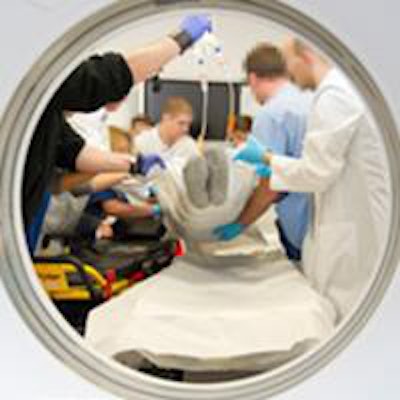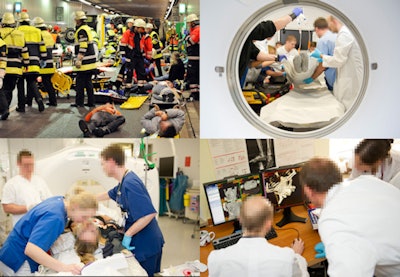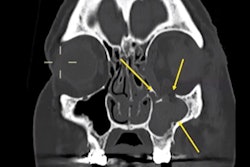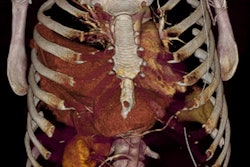
Locating a CT scanner as close as possible to the emergency room and implementing an effective triage system can make a huge difference in mass casualty and polytrauma incidents, according to researchers in Munich who conducted a simulated exercise involving 70 patients.
"Facility design has a major influence on the time needed for in-house treatment. Short distances allow reaching end points within 22 minutes," noted lead investigator Dr. Fabian Mueck, a radiology resident at the department for clinical radiology at the Ludwig-Maximilian's University Munich. "Considering CT, it is possible to serve up to six patients per scanner hour by using a standard protocol; and up to a theoretical maximum of 13 patients by using a CT triage procedure."
 Actors were employed to stage a simulated mass casualty incident involving 70 patients. Images courtesy of the University of Munich.
Actors were employed to stage a simulated mass casualty incident involving 70 patients. Images courtesy of the University of Munich.Optimum use of staff, technical, and facility resources is vitally important in a mass casualty incident, he explained at RSNA 2015 in Chicago last month. At Mueck's own hospital, a new central emergency department opened last year. The emergency room is directly connected to the CT scanner suite and there are very short distances between the emergency room, CT scanner room, operating theaters, and intensive care units.
"Therefore, we hope to be prepared for future incidents as fully as possible," he told AuntMinnieEurope.com in an email. "In this central emergency department, all basic requirements necessary for optimized polytrauma/mass casualty incident handling are fulfilled."
An important point, which came as a big surprise to the team, was the limited capacity of the IT infrastructure in certain situations. Hospitals may have a functional IT environment for an amount of data in regular patient care, but this may not be sufficient for radiology applications in a mass casualty incident in which a large amount of data has to be transferred reliably from the CT scanner to the PACS in a limited time, Mueck continued.
Simulated incident
The main aim of the Munich group's study was to compare the in-house workflow of two level 1 trauma sites in the case of a mass casualty incident, with a particular focus on CT management.
A mass casualty incident of 70 patients was simulated by actors in November 2012. Using a local mass casualty incident patient distribution matrix, the on-site triage assigned seven cases to trauma site A, which involved long in-house distances. Another five patients were sent to the independent second trauma site B, which had short in-house distances within the same hospital. In a realistic simulation of in-house treatment, Mueck et al measured and compared several time points, including time between arrival and triage, time to trauma room, time to CT, and time to one of the two possible ending points, which were arrival at the intensive care unit or at the operating theater.
Site A needed more time from arrival to reach the desired end point (A = 31.84 minutes; B = 21.60 minutes; P = 0.059). Depending on the distances, the times were longer to both the trauma room (A = 8.46; B = 2.73, P = 0.008), and CT room (A = 1.81; B = 0.06, P = 0.008). The observed shorter stay on the CT table did not compensate these effects (A = 6.42; B = 7.31, P = 0.705).
"We tried to calculate the examination time in advance of the exercise. The results we observed were in the estimated range," he noted in an email. "In contrast, we were surprised by other findings. Total time from admission to definitive patient care (end points defined as patient reaches intensive care unit or operating room) was shorter than expected. Additionally, more extensive preparation of patients in the trauma room had a smaller impact, while long distances between the trauma and CT rooms as well as distances to operating rooms or intensive care units showed a larger influence on duration of in-house treatment."
 "We should try to be prepared as much as possible," Dr. Fabian Mueck said.
"We should try to be prepared as much as possible," Dr. Fabian Mueck said.Normally, the radiology department offers imaging services for different disciplines, and therefore the radiology department is often located in a central area of a hospital to optimize in-house treatment of inpatients, he added. The study results suggest that long in-house distances have a major influence on treatment time, and to optimize workflow in polytrauma/mass casualty incidents, a CT scanner should be as close as possible to the emergency room.
Meuck has received a lot of feedback since RSNA 2015, especially given the increased perception of the relevance of this topic. A lot of institutions, most notably smaller hospitals surrounding large cities, are striving to be prepared for a mass casualty incident following the increasing threat levels.
He said he had no further knowledge or data about the emergency care in last November's Paris bombings, but he recommended Hirsch et al's article ("This is the civil application of war medicine") in the Lancet about the medical care and hospital setup in Paris in a recently published Lancet article. He was particularly impressed by this statement by the authors: "Although emergency physicians have been receiving training in disaster medicine for more than 30 years, never before had such a number of victims been reached and so many wounded been operated on urgently. A new threshold has been crossed."
Challenges for staff
Independently of its cause, it is known that a mass casualty incident is a major challenge for trained teams as well, according to Mueck. The difference between training and a real-life situation is a problem, but all trauma teams should undergo sufficient and regular training to give them a chance to improve their skills to cope with these problems with tried and tested routines.
"This is especially important for all trauma team members, who are in the first line of patient care, like anesthetists, surgeons, and also radiologists," he said. "Unfortunately, in my personal opinion, for these extraordinary situations we cannot be perfectly prepared, but we should try to be prepared as much as possible."
Looking to the future, the Munich researchers plan to evaluate a dedicated mass casualty incident imaging protocol, which may decrease scan time and increase patient scan capacities. In a second stage, they will try to evaluate the performance and accuracy of radiologists in case of an emergency setting simulating both a terrorist attack and a "normal" mass casualty incident such as a bus accident. This is important because in the first minutes to hours, staff may be limited and there may be a difference between what is technically possible and what is humanly achievable without a relevant impairment of diagnostic safety, Mueck concluded.



















